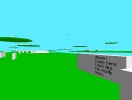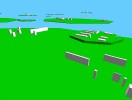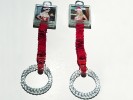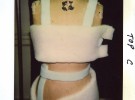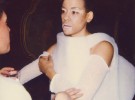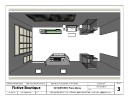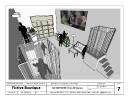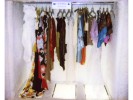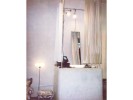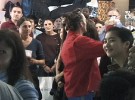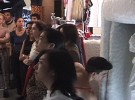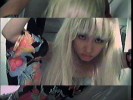Installation involving a 3D Computer model consisting of a navigable mile-wide virtual cube of visual and textual information.
In the group exhibit BAD SCIENCE, INTERACTIVE INSTALLATIONS AND FABRICATED DIALOGS, presented by mixed mess@ge, in association with The DTW Gallery, New York City
View screen captures:
Project Description:
The title refers both to the look of digitally produced landscape, but also to what’s on the horizon if present trends in our cultural perception of space continue. The work can played with like a big video game you fly around in and explore, but my hope is that for some it may be viewed as a sort of critique of western visualization. It is about the Western historical perception of landscape in the most basic sense.
Â
Digital Vista
Review by Chris Jordan
[abstract]
Digital navigable environment projected on surface of metal tube cube approximately 8′ x 8′ x 8′; two facing surfaces covered and used as digital projection space; pillows, carpet, keyboard and trackball.
[details]
Digital Vista is a multifaceted artwork that questions the massive societal movement towards all things virtual. It blurs the boundary between digital and tangible through viewer interaction, both physical and mental. The traditional role of artist-audience is torn down through the collaborative and interactive nature of the installation.
This is a participatory artwork, utilizing the calm stillness of Zen to create a gateway into the virtual experience. The real life space, contained within the square mesh, welcomes you as well as supports you through the virtual experience. Once you are seated and Paul has coached you, like the Zen master, on the controls, you begin the exploration. The first thing you see are three dimensional green lillypad-like extrusions floating on a cyan background. Zooming into these stark structures, you notice gray tombstone-like obelisks on them. Further navigation towards these obelisks reveals simple words and phrases on their surfaces. As you stop and look around these spaces, you begin to notice words combining into more complex thoughts as different obelisks line up in 3 dimensional space. While shifting around these cubes, the combinations change; some disappear, some emerge, positions are altered, and you begin to realize the delightful complexity of this experience.
Your mind soars, dreamlike, while your body rests comfortably within the peacefulness of the cushioned cube. For me it felt like an out of body experience. I zoomed from lillypad to lillypad, creating different motions, rhythms, and phrases out of the objects. It was exciting, thinking of Burrough’s work with audio cutups in the 50’s, conjuring 3D meaning out of the recombination of words. The smooth response of the system allows you to hunker down in a cluster of cubes, and spin around, the words and shapes combining in a blur of meaning, form and phrase fusing into one.
As I became more immersed, the starkness of the environment created a feeling of walking through a graveyard. I then interpreted these tombstones as a memorial to the actual words written on them. Initially the flash and discov- ery of this virtual space gave the Digital Vista meaning, showing humanities moth-like draw to all things bright and shiny. But paradoxically it is a statement on how that flash is eroding society’s connection to not just literature, but the use of words. We see this every day, as more and more people turn on, and tune out. People have been reading less and less, opting instead for the somnambulism of television, and the bang of video games. Digital Vista not only questions that shift in society, but creates a memorial to the casualties in this future atmosphere.
The Dadaist notion of the “Exquisite Cadaver” opened the 20th century with word play exploration as an art form. Now at the close of the century, Paul Clay’s Digital Vista is appropriately representing the use of language or words as the modern Cadaver.
Project Credits:
Digital Vista by Paul Clay
Text: Karen Williams with additional text by Paul Clay and Ed Pastorini.
Early versions of the presentation included contributions by Yuki Takagi, Willyum Delirious, and Jamie Leo.
A pair of objects made at invitation, to be auctioned as part of a benefit for Harvey Lichtenstein in celebration of his retirement from the Brooklyn Academy of Music (BAM) after his 32-year reign as the institution’s executive director. In 1999 President Clinton awarded Mr. Lichtenstein the National Medal of Arts.
Made from old fashioned silicone furniture sliders, lingerie garters, shower curtain hooks, 50’s era holiday fetish images via internet download, picture hanger hardware.
Project Description:
Mr. Lichtenstein is famed for his consistent presentation of cutting edge work exploring difficult issues, including power, sex, and gender. His first season at BAM (1968-1969) included Alban Berg’s sensational and Lurid opera “Lulu,” in which the main character actively prostitutes herself and also included The Living Theater’s “Paradise Now,” involving audience participation, and a notorious scene in which actors recite a list of social taboos that include nudity, while themselves disrobing; which led to multiple arrests for indecent exposure, during the life of the work.
The pair of objects is designed to resemble earrings or Christmas ornaments and references fashion and costume fetishization, while at the same time evoking a sense of “wholesome” 1950s era nostalgia.
The work partly explores what it means for a powerful male from this era to retire. The figures suggest theater starlets, a tawdry version of the Radio City Rockettes Christmas show, and notions of the “casting couch”. In one reading, we see the oppressed woman presented in the attitude of trophy gift and rightfully deserved object for the male who has achieved a heightened social status, and who will now, in retirement, reap the rewards of a lifetime of oppressive power accrual. Though gendered, they also stand in for all people who must labor and “put out” for the powerful in order to survive.
At the same time a heightened sense of the humorous absurdity in codified gender and power roles, (the awareness of which might more typically be found within gay and transgender communities,) could read these as idillic souvenirs of a bygone era. A kind of tribute to an imaginary past where sex is idealized and the fictional roles of “Boy” or “Girl”, Â “Dominant” or “Submissive”, “Object” or “Objectifier” can temporarily be inhabited and reveled in by anyone, no mater what their gender or orientation. A kind of bacchanalian celebration of richly deserved reward.
They are intended to suggest decoration and celebration, provocation and transgression, costume and theatrical spectacle, all in honor of the man who founded the Next Wave Festival, and showed us things that others were afraid to reveal.
An art runway show featuring a series of artist/designers which included dacron, string and foam outfits designed by Paul Clay, with agency models. Part of the event Culture Jam, Night Owls, New York City.
Â
Project Description
While working a freelance day job for a professional drapery and rigging company, I ran across a material called Bonded Dacron made from polyethylene terephthalate, a thermoplastic polymer resin of the polyester family used in synthetic fibers.
Dacron is used in upholstery, and looks a little like the fake cotton ball snow used in miniature scenes at Christmas time, but has high tensile strength and resistance to stretching. It is very light weight, can be purchased in bulk in 30″ or greater width rolls, and is approximately one inch thick.
When I was invited to participate in this group exhibit/runway show, I thought Dacron and foam rubber might be interesting sculptural materials to work with. The bulky physical form was a good challenge when trying to create something that could be worn as fashion.
Credits for Fictive’s contribution:
Paul Clay (Designer)
Tsukuru Asada (Photographer)
Models:
Christie Dinham (New York Model Management)
Rodger Gary (New York Model Management)
Munyana ( Model)
Tiffany ( Model)
Ebon (Model)
An illusory retail space and lounge environment…experience the joys of actual shopping -Â without the hassle of having to take it all home.
An art installation and set of performances at the temporary site EXPO | SURE, 242 Elizabeth Street, New York City, presented through the Downtown Arts Festival, in space created by Pompei AD for Levi’s® Vintage Clothing, festival sponsor.
Â
Design Images:
 Â
Photo Documentation of Installation:
Video Documentation Stills of Performance:
Fictive Boutique Video Stills:
Fictive Boutique Video Excerpt:
[tubepress mode=’playlist’, playlistValue=’0A1237D6EA525A5D’]
Project Description:
The idea behind Fictive Boutique was to create a fake clothing store where people could “shop” but where nothing was actually for sale – a way of provoking thought about boutique culture and the nature of shopping.
Fictive Boutique occupied the front third of a former retail space in Nolita, procured by the design firm Pompei AD, as a “Pop Up” display space showcasing New York artists. Three projects were chosen with curatorial input from the Downtown Arts festival. The DAF for 1999, and the entire Expo Sure event was sponsored by Levi’s®. The project Fictive Boutique was one of three projects chosen for the exhibit.
In addition to the fake clothing store installation, Fictive Boutique also included a series of live performances in which dancers performed a set of choreographed actions in the “dressing rooms” of the boutique and were captured by multiple video cameras. These video feeds were further manipulated by two VJs, live, in time to music from a dj, and were combined with text about the nature of shopping. A live audience watched the spectacle as it was projected onto the walls of the space.Â
A few random thoughts: As shopping has become the main form of activity in public space, boutiques in Nolita and the surrounding Downtown area have become a breeding ground for emerging culture. They have begun crossing traditional boundaries of what a store is supposed to do and be, and are creating spaces where creative people come to hang out and exchange the kind of day to day information that, through the process of accretion, actually creates positive growth and change.Â
Young designer/artists are making small numbers of items, or even one-offs, not solely as a means to generate samples, but as the actual mode of production. This low volume means low profit, especially if the clothing is priced so that like minded individuals can afford it, but the process of making what they love and controlling the content of what is produced outweighs, for them, the drive to purely do business. The argument goes “ignore everything you’re supposed to worry about and make the things you yourself want to see in the world. Opportunities will follow, allowing you to continue.â€
Along with this is a radical shift from emphasis on design to emphasis on styling. In  Tokyo a great number of contemporary street fashion mags have sprung up because kids are combining elements of clothing from so many different cultural esthetics into a single ensemble, that the process of simply reporting on new designers doesn’t reveal any of this whole alternative cultural aesthetic.
In Italy a new class of design professional- a cross between fashion researcher/color predictor and actual designer is occurring as professionals buy vintage, style it, cut, paste and modify, assign alternate colors through swatching, and then advise clothing companies all the way through the production process. They don’t do fashion sketches, and don’t have final say, yet they are essentially the original authors of the clothing’s aesthetic.
Along with this also goes a general shift from things mass produced back to an appreciation of hand crafted work. As styling begins to have similar weight to design, there is now a new process of using historically iconic, mass produced items, in association with radical craft pieces and young designer’s one-offs to create a look and make cultural statements through clothing. In the current fashion era, people aren’t so ready to let others control what there is to wear. Each individual becomes, in a way, his or her own designer.
Credits:
Conceived and Produced by: Paul Clay
Choreography: David Neumann
VJs: Paul Clay and Willyum Delirious
DJ: Hiro
Live Performance: Miho Nikaido, Terry Bartlett,
David Neumann, and Yukiko Takagi
Clothing Design: Yukiko Takagi
Interior Design: Paul Clay
Presented by:
The Downtown Arts FestivalÂ
Expo | SureÂ
Levi’S® Vintage Clothing
A Project of Fictive.Â
Construction:
Mark Power, Torsten Schneider, Toshimi , ArronÂ
Cantor, Joe Foley, Shelly McGuinness, Clement Remy, Noriko.Â
Patterns Advisor: Lise Kovar
Special Thanks:Â
Levi’s ® Vintage ClothingÂ
Ron, Alison , Michael , Lynn, Laura ,Zoe, Jonathan, Vajra, Henry,Â
Shannon, and everyone at Pompei AD.Â
Simon, Craig, and Downtown Arts ProjectsÂ
Lipe, and everyone at LANGUAGEÂ
Joe Plotkin, and Broadway.netÂ
Peter Scharff and Scharff WeisbergÂ
CovadÂ
Apple Computer
Shoes for the performance generously donated by:Â
Norman Smitherman through Suzi Funahara and Antenna 88.Â
(For more info, Contact # 212.645.0700)




